How to Propagate String of Buttons (Crassula perforata): A Guide to Spreading the Spiral

String of Buttons (Crassula perforata) is not only a visual standout—it’s also one of the easiest succulents to propagate. Whether you’re growing it in containers, rock gardens, or bright indoor spots, this fast grower rewards even beginner gardeners with new plants from just a few clippings. In this guide, we’ll walk through every reliable propagation method to help you multiply your collection.
Table of Contents
Why This Succulent Is So Easy to Multiply
Native to South Africa, Crassula perforata naturally spreads by sending out offsets and sprawling stems that root wherever they touch soil.
Its stacked, spiraling leaves make it visually unique, but its forgiving nature makes it ideal for propagation by stem cuttings, offsets, division, and even in water with a few precautions.
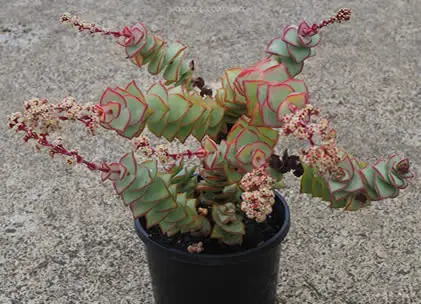
These methods apply to all popular varieties, including Crassula perforata var. perforata, ‘Variegata’, ‘Giant Form’, and hybrids like ‘Baby’s Necklace’.
Stem Cuttings: The Easiest Method
Stem cuttings are the go-to method for propagating String of Buttons.
It’s simple, quick, and highly successful.
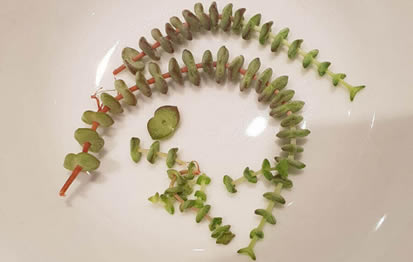
-
Choose a healthy stem: Select a section at least 3–5 inches long with plump, undamaged leaves.
-
Make a clean cut: Use sterilized scissors or garden snips to remove the cutting just below a node.
-
Remove the bottom leaves: Strip away 1–2 sets of leaves from the base to expose some stem for planting.
-
Let it callous: Lay the cutting on a dry surface for 2–4 days so the cut end can heal and scab over.
-
Plant in dry soil: Insert the cutting into a well-draining cactus or succulent mix. The exposed stem should be in contact with soil, but not buried too deep.
-
Wait to water: Hold off on watering for 4–5 days. Then, mist or lightly water when the soil is fully dry.
New roots typically develop in 2–3 weeks, and new growth from the top will confirm success.
Propagation by Offsets
Mature String of Buttons plants often produce little offshoots at the base or along their trailing stems. These offsets can easily become standalone plants.
-
Gently separate the offset: Use your fingers or snips to detach it from the parent plant.
-
Inspect for roots: Some offsets may already have tiny roots; if not, treat them like stem cuttings.
-
Let dry for a few days: This reduces the risk of rot once planted.
-
Pot into a small container: Use dry, well-draining soil and avoid watering immediately.
-
Resume light watering after 4–5 days and place in bright, indirect light.
Offsets root quickly and often establish even faster than traditional cuttings.
Division for Overgrown Clumps
If your String of Buttons has become dense and full, division offers a way to manage its shape and grow multiple plants at once.
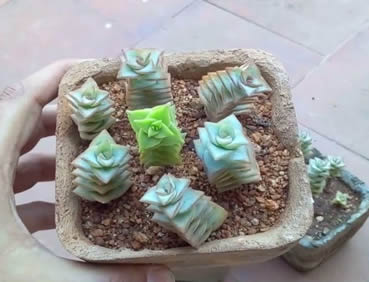
-
Remove the plant from its pot and shake off excess soil.
-
Locate natural separations: Look for clusters of stems with their own roots.
-
Gently pull or cut apart sections using your hands or a clean knife.
-
Let any wounds dry for a day or two before replanting.
-
Pot each division separately and treat it as a mature plant.
Division works best during the active growing season (spring or early summer) and is useful when the base of the plant becomes too crowded.
Water Propagation (Yes, It’s Possible—With Care)
While not typical for succulents, String of Buttons can root in water if done cautiously.
-
Prepare a cutting the same way as you would for soil—trim and remove lower leaves.
-
Use a narrow container so the stem remains upright and only the base touches the water.
-
Keep in bright, indirect light and avoid hot windowsills.
-
Change the water every few days to prevent bacteria buildup.
Bonus Tip: Add a few drops of diluted, succulent-safe fertilizer (like a 2-7-7 formula like this one) to the water once a week to gently stimulate root growth.
Once roots are at least 1 inch long, pot your cutting into soil and water lightly after a few days of adjustment.
Outdoor Propagation Tips
In warm, dry climates (zones 9–11), String of Buttons can be propagated outdoors year-round.
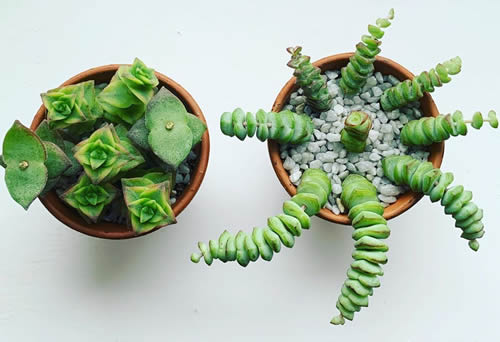
-
Take cuttings early in the day and plant them directly into dry, sandy soil.
-
Choose a lightly shaded area to reduce stress from full sun.
-
Avoid propagating during wet seasons or just before temperature drops.
In cooler climates, wait until late spring or summer to propagate outdoors, or root cuttings inside and transfer them later.
Common Propagation Problems
Stem rot or mushy cuttings – Usually caused by planting before the cut end was dry. Always callous first.
Shriveled leaves – Can happen during rooting. Don’t overwater—light misting is enough until roots form.
No rooting after 3+ weeks – Move to a brighter spot or add a bit of warmth. Cold or dark conditions slow propagation.
Fungus or mold on cuttings – Improve airflow and avoid humidity domes. Water sparingly and ensure clean tools.
Popular String of Buttons Varieties to Propagate
Each of these popular forms of Crassula perforata propagates the same way:
-
Crassula perforata var. perforata – Classic stacked form with pale green leaves and pink margins.
-
Crassula perforata ‘Variegata’ – Cream, yellow, and green variegation with bright pink highlights under stress.
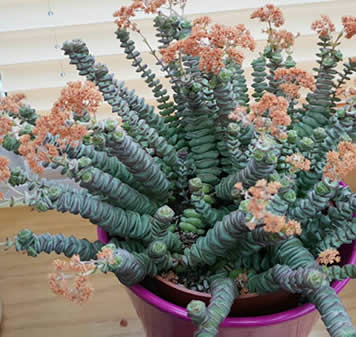
Crassula perforata × rupestris hybrid, Baby’s Necklace -
Crassula perforata ‘Giant Form’ – Larger leaves and thicker stems for a bolder architectural look.
-
Crassula perforata × rupestris (‘Baby’s Necklace’) – Tight, rounded leaves in stacked spirals; a collector’s favorite.
Each one brings its own personality to a succulent garden or arrangement—and they all root with minimal effort.
Final Thoughts
Propagating String of Buttons is not just easy—it’s one of the most satisfying succulent projects you can take on.
With a few cuttings or offsets, a warm window, and some patience, you can turn one quirky plant into a collection of spiraling beauties.
Stick to dry soil, let things callous, and go easy on the water—and this plant will do the rest.
Be sure to read our care guide String of Buttons Care: How to Grow Crassula perforata Indoors and Out.
Thanks for reading! I'm Michael — houseplant fanatic and your Pinterest plant guide.
Follow me on Pinterest for fresh updates 🌿



